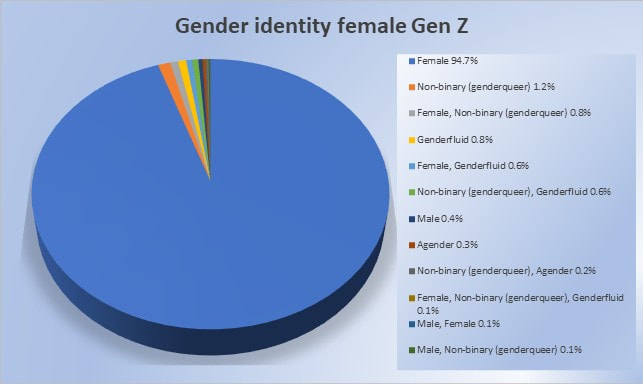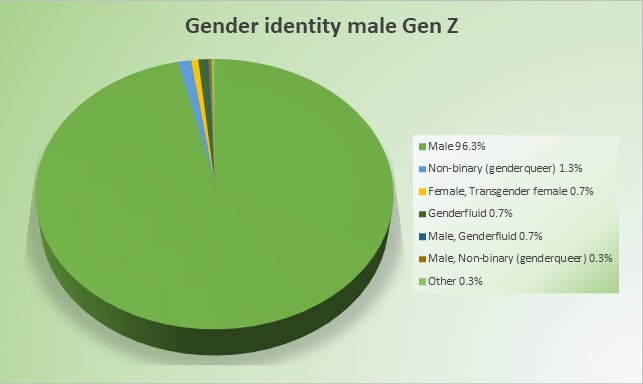Gender Identity
Gender can be described as a complex concept that encompasses a range of identities, expressions, roles, and societal expectations about behaviors, activities, and attributes that are considered appropriate for men and women as well as gender-diverse people. While (biological) sex is about biological and physical differences, gender is about personal, societal, and cultural perceptions of what it means to be male, female, or other genders. Therefore, gender is largely seen as a social and cultural phenomenon that varies across societies and cultures.
Gender identity refers to people's internal sense of their gender. It's how individuals perceive themselves and what they call themselves. This can be the same as or different from the sex assigned at birth. Individuals' gender identity can be male, female, a blend of both, neither, or something different. And most importantly, people may have a gender identity that changes over time. It's essential to note that gender identity and sexual orientation are independent of each other. They are distinct but interconnected aspects of a person's identity. As we will see, a person's gender identity doesn’t determine their sexual orientation and vice versa. A person who is transgender can be of any sexual orientation, just like a person who is cisgender.
Currently, the most used gender identities are:
Please keep in mind that these are just the most commonly used identities. There are other terms people use to describe their gender identity, and some people may define the above terms differently. Therefore, we should always keep in mind that everyone's experience with their gender identity is unique and personal and that we have no right to question people's self-identified gender.
Among the 3,000 Gen Z students participating in my survey between 2016 and 2022, 97% identified as female (77%) or male (20%) and 3% as transgender/gender-nonconforming (TGN). However, that percentage changed considerably after 2020. In the data collected from 2016-2020, 98% of students were female or male, and only 2% TGN. When we look at the responses from 2021 and 2022 only, the percentage of TGN is at 5%.
Gender identity refers to people's internal sense of their gender. It's how individuals perceive themselves and what they call themselves. This can be the same as or different from the sex assigned at birth. Individuals' gender identity can be male, female, a blend of both, neither, or something different. And most importantly, people may have a gender identity that changes over time. It's essential to note that gender identity and sexual orientation are independent of each other. They are distinct but interconnected aspects of a person's identity. As we will see, a person's gender identity doesn’t determine their sexual orientation and vice versa. A person who is transgender can be of any sexual orientation, just like a person who is cisgender.
Currently, the most used gender identities are:
- Female: Any person who identifies as a woman or girl independent of their biological sex.
- Male: Any person who identifies as a man or boy independent of their biological sex.
- Transgender: Any person whose gender identity differs from the biological sex they were assigned at birth. Transgender (or trans) women were assigned a male sex at birth but identify as female; transgender (or trans) men were assigned a female sex at birth but identify as male.
- Non-Binary: This is a term for people who do not exclusively identify as a man or a woman. Non-binary individuals may identify as a mix of both genders, neither, or a different gender entirely.
- Genderqueer: Similar to non-binary, this is a term for people who do not identify solely as male or female. They might identify as a combination of genders or as different genders at different times.
- Genderfluid: This is a term for people whose gender identity isn't fixed and can change over time. They may identify as male, female, both, or neither at different times.
- Agender: This term is used by individuals who do not identify with any gender. They may see themselves as being genderless or without a gender identity.
- Two-Spirit: This is a term used by some Indigenous cultures to recognize people who embody both masculine and feminine spirits.
Please keep in mind that these are just the most commonly used identities. There are other terms people use to describe their gender identity, and some people may define the above terms differently. Therefore, we should always keep in mind that everyone's experience with their gender identity is unique and personal and that we have no right to question people's self-identified gender.
Among the 3,000 Gen Z students participating in my survey between 2016 and 2022, 97% identified as female (77%) or male (20%) and 3% as transgender/gender-nonconforming (TGN). However, that percentage changed considerably after 2020. In the data collected from 2016-2020, 98% of students were female or male, and only 2% TGN. When we look at the responses from 2021 and 2022 only, the percentage of TGN is at 5%.
A closer look at the information provided by TGN students shows that only half of these students selected one identity only (agender 0.3%, genderfluid 0.8%, non-binary 1.2%), the other half selected two or more identities.
Among the respondents who had been assigned female at birth, 5% selected one or more TGN identities. That proportion was less than 4% for respondents who were assigned male at birth.
When we look at which sexual orientation students selected based on their gender identity, we find that only two-thirds of students who identify as female are heterosexual. One in five is bisexual; the others mainly select asexual, homosexual (lesbian), or pansexual.
Students who identify as male are mostly heterosexual (85%), with smaller numbers of bisexual and homosexual (gay) individuals.
Not surprisingly, the data look different for the group of transgender/gender-nonconforming (TGN) students. Three out of ten TGN respondents are either bisexual or pansexual, two out of ten are homosexual (gay/lesbian), and one out of eight is asexual.
Among the respondents who had been assigned female at birth, 5% selected one or more TGN identities. That proportion was less than 4% for respondents who were assigned male at birth.
When we look at which sexual orientation students selected based on their gender identity, we find that only two-thirds of students who identify as female are heterosexual. One in five is bisexual; the others mainly select asexual, homosexual (lesbian), or pansexual.
Students who identify as male are mostly heterosexual (85%), with smaller numbers of bisexual and homosexual (gay) individuals.
Not surprisingly, the data look different for the group of transgender/gender-nonconforming (TGN) students. Three out of ten TGN respondents are either bisexual or pansexual, two out of ten are homosexual (gay/lesbian), and one out of eight is asexual.




